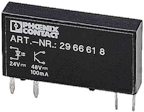Optical connectors and their applications

An optocoupler (or optocoupler, as it began to be called recently) structurally consists of two elements: an emitter and a photodetector, united, as a rule, in a common sealed housing.
There are many types of optocouplers: resistor, diode, transistor, thyristor. These names indicate the type of photodetector. As an emitter, a semiconductor infrared LED with a wavelength in the range of 0.9 … 1.2 microns is usually used. Red LEDs, electroluminescent emitters, and miniature incandescent lamps are also used.
The main purpose of optocouplers is to provide galvanic isolation between signal circuits. Based on this, the general principle of operation of these devices, despite the difference in photodetectors, can be considered the same: the input electrical signal arriving at the emitter is converted into a light flux, which, acting on the photodetector, changes its conductivity.
If the photodetector is photoresistor, then its light resistance becomes thousands of times less than the original (dark) resistance if the phototransistor — irradiation of its base produces the same effect as when current is applied to the base conventional transistorand opens.
As a result, a signal is formed at the output of the optocoupler, which in general may not be identical to the shape of the input, and the input and output circuits are not galvanically connected. An electrically strong transparent dielectric mass (usually an organic polymer) is placed between the input and output circuits of the optocoupler, the resistance of which reaches 10 ^ 9 ... 10 ^ 12 Ohm.
Industry-produced optocouplers are named based on the current semiconductor device designation system.
The first letter of the designation of the optocoupler (A) indicates the starting material of the emitter — gallium arsenide or a solid solution of gallium-aluminum-arsenic, the second (O) means the subclass — optocoupler; the third shows to which type the device belongs: P — resistor, D — diode, T — transistor, Y — thyristor. Next are numbers, which mean the number of the development, and a letter - this or that type group.
Optocoupler device
The emitter — an unwrapped LED — is usually placed in the upper part of the metal case, and in the lower part, on a crystal holder, is a reinforced silicon photodetector, for example, a photothyristor. The entire space between the LED and the photothyristor is filled with a solidifying transparent mass. This filling is covered with a layer that reflects light rays inward, which prevents light from scattering outside the work area.
A slightly different design from the described resistor optical coupler... Here a miniature lamp with an incandescent filament is installed in the upper part of the metal body, and a photoresistor based on cadmium selenium is installed in the lower part.
The photoresistor is manufactured separately, on a thin sital base. A film of a semiconducting material, cadmium selenide, is sprayed on it, after which electrodes made of a conductive material (e.g. aluminum) are formed. The output wires are welded to the electrodes. The rigid connection between the lamp and the base is provided by a hardened transparent mass.
The holes in the housing for the optocoupler wires are filled with glass. The tight connection of the cover and the base of the body is ensured by welding.
The current-voltage characteristic (CVC) of a thyristor optocoupler is approximately the same as that of a single thyristor… In the absence of input current (I = 0 — dark characteristic), the photothyristor can turn on only at a very high value of the voltage applied to it (800 … 1000 V). Since the application of such a high voltage is practically unacceptable, this curve makes purely theoretical sense.
If a direct operating voltage (from 50 to 400 V, depending on the type of optocoupler) is applied to the photothyristor, the device can be turned on only when an input current is supplied, which is now the driving one.
The switching speed of the optocoupler depends on the value of the input current. Typical switching times are t = 5 … 10 μs. The turn-off time of the optocoupler is related to the process of resorption of minority current carriers in the junctions of the photothyristor and depends only on the value of the flowing output current.The actual value of the tripping time is in the range of 10 … 50 μs.
The maximum and operating output current of the photoresistor optocoupler decreases sharply when the ambient temperature rises above 40 degrees Celsius. The output resistance of this optocoupler remains constant up to the value of the input current of 4 mA, and with a further increase in the input current (when the brightness of the incandescent lamp begins to increase) it sharply decreases.
In addition to those described above, there are optocouplers with the so-called open optical channel... Here, the illuminator is an infrared LED, and the photodetector can be a photoresistor, photodiode or phototransistor. The difference between this optocoupler is that its radiation goes out, is reflected by some external object and returns to the optocoupler, to the photodetector. In such an optocoupler, the output current can be controlled not only by the input current but also by changing the position of the outer reflective surface.
In open optical channel optocouplers, the optical axes of the emitter and receiver are parallel or at a slight angle. There are designs of such optocouplers with coaxial optical axes. Such devices are called optocouplers.
Application of otrons
Currently, optocouplers are widely used, especially to combine microelectronic logic blocks containing powerful discrete elements with actuators (relays, electric motors, contactors, etc.), as well as for communication between logic blocks that require galvanic isolation, modulation of constant and slowly changing voltages, conversion rectangular pulses in sinusoidal oscillations, control of powerful lamps and indicators of high voltage.
